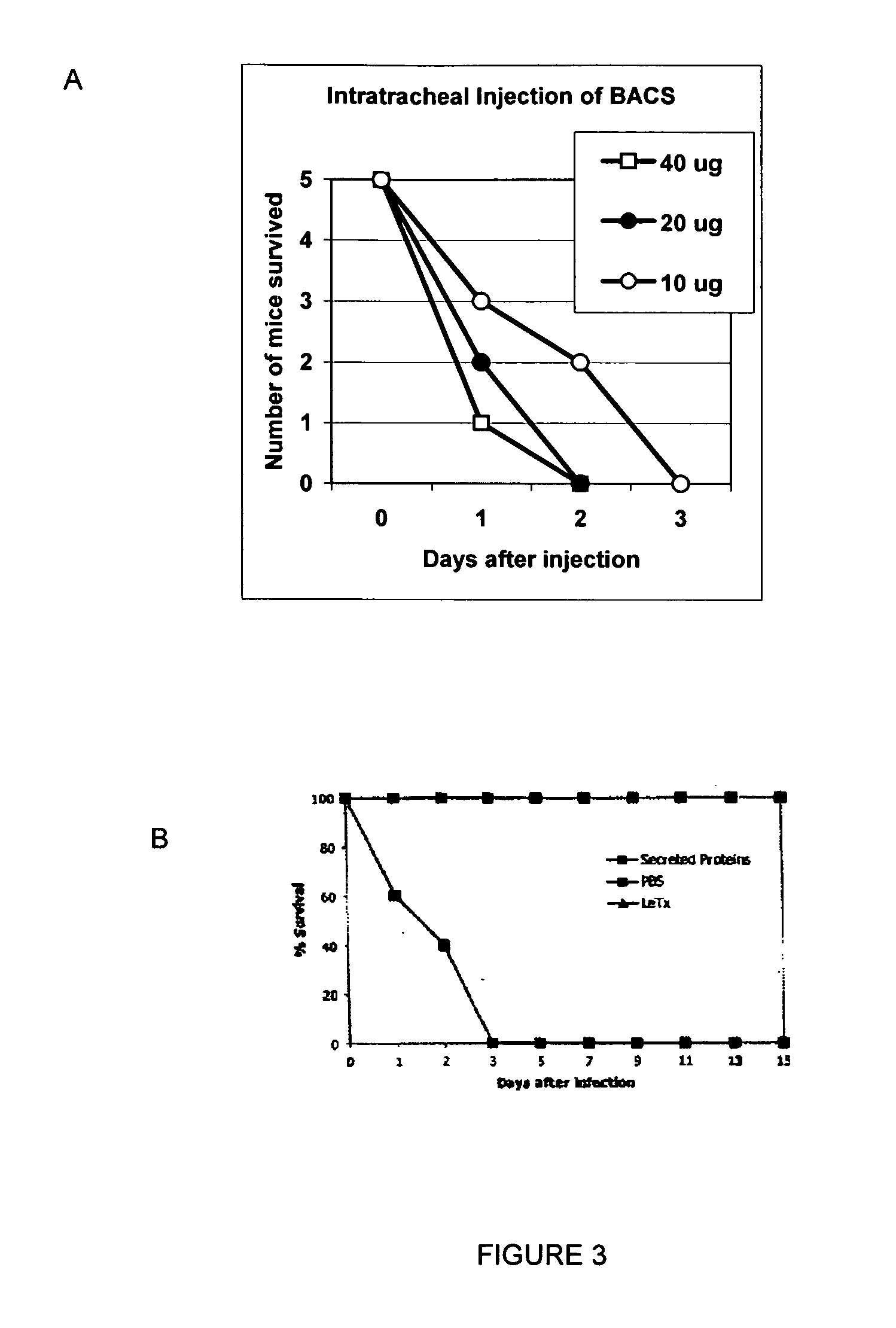Combination therapy for anthrax using antibiotics and protease inhibitors
- Summary
- Abstract
- Description
- Claims
- Application Information
AI Technical Summary
Benefits of technology
Problems solved by technology
Method used
Image
Examples
example 1
Materials and Methods
[0050] Microbial strains. The non-encapsulated Bacillus anthracis strain 34F2 (Sterne) [pXO1+, pXO2−] obtained from the Colorado Serum Company (Boulder, Colo.) was used in animal challenge experiments. The 50% lethal doses (LD50s) by the inraperitoneal (i.p.) route were established earlier (Popov et al., 2004) and the LD50 value for intraperitoneal challenge for DBA2 mice was found to be 3×106 spores per mouse. The non-encapsulated, atoxigenic strain of B. anthracis (delta Ames) [pXO1−, pXO2−] was provided by Dr. J. Shiloach (National Institutes of Health, Bethesda, Md.). B. cereus strain ATCC #11778 and B. subtilis strain #23857 were purchased from American Type Culture Collection (Manassas, Va.).
[0051] Mice. Female DBA2 mice (9 weeks old) were obtained from Taconic (Germantown, N.Y.) and were used in all experiments described in the examples that follow.
[0052] Reagents. The following substances were used: ciprofloxacin (ICN Biomedicals, lot no. 4913F), pho...
example 2
Genomic Analysis of B. Anthracis Secreted Proteins as Potential Virulence Factors
[0061] In order to evaluate the pathogenic effect of B. anthracis proteins other than the known lethal and edema toxins, a nontoxigenic and nonencapsulated strain of B. anthracis, delta Ames, was analyzed. The delta Ames strain lacks both plasmids, pXO1 and pXO2.
[0062] First, an analysis of the chromosome sequence of the B. anthracis Ames strain was performed based on shared sequence homology with pathogenic factors in other bacterial species. (Supran et al., 2002; Read et al., 2003) This analysis revealed a variety of potential virulence-enhancing factors, including collagenases, phospholipases, haemolysins, proteases, and other enterotoxins. In fact, the B. cereus group of bacteria, which are pathogenic to humans or insects and includes B. anthracis, B. thuringiensis, and B. cereus, has more sequences that are predicted to be secreted proteins than does nonpathogenic B. subtilis (Read et al., 2003)...
example 3
Hemorrhagic and Collagenolytic Activities of Anthrax Proteases
[0066] The proteins secreted by three Bacillus species (B. anthracis, B. cereus, and B. subtilis) into culture media were prepared by successively inoculating culture media with spores and incubating them overnight at 37° C. The bacterial cells were removed by centrifugation and the supernatant was sterilized by filtering through a 0.22μ filter. The supernatant was then concentrated 50-fold using an ultrafiltration device, such as an Amicon Ultra 15 filter (Millipore, MA) with a 10 KDa cutoff size. SDS-PAGE gel separation of culture supernatant (“BACS”) (FIG. 1A) demonstrates its protein content. Similar procedures were used to prepare culture supernatants for B. cereus (“BCCS”), ATCC #11778, and B. subtilis (“BSCS”), ATCC #23857.
[0067] Gelatinase and collagenase activity of BACS is readily detected by zymography using collagen type I or gelatin (denatured collagen) (FIGS. 1D and 1E). A major band of gelatinase activit...
PUM
| Property | Measurement | Unit |
|---|---|---|
| Time | aaaaa | aaaaa |
| Digital information | aaaaa | aaaaa |
| Time | aaaaa | aaaaa |
Abstract
Description
Claims
Application Information
 Login to View More
Login to View More - R&D
- Intellectual Property
- Life Sciences
- Materials
- Tech Scout
- Unparalleled Data Quality
- Higher Quality Content
- 60% Fewer Hallucinations
Browse by: Latest US Patents, China's latest patents, Technical Efficacy Thesaurus, Application Domain, Technology Topic, Popular Technical Reports.
© 2025 PatSnap. All rights reserved.Legal|Privacy policy|Modern Slavery Act Transparency Statement|Sitemap|About US| Contact US: help@patsnap.com



